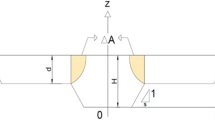Abstract
Prediction of boundary shear force distributions in open channel flow is crucial in many critical engineering problems such as channel design, calculation of losses and sedimentation. During floods, part of the discharge of a river is carried by the simple main channel and the rest is carried by the floodplains. For such compound channels, the flow structure becomes complicated due to the transfer of momentum between the deep main channel and the adjoining floodplains. The complexity further increases when dealing with a compound channel with non-prismatic floodplains. Knowledge of momentum transfer at the different interfaces originating from the junction between the main channel and floodplain can be acquired from the distribution of boundary shear in the subsections. The calculation of boundary shear and depth average velocity in non-prismatic compound channel flow is more complex and simple conventional approaches cannot predict the boundary shear and depth average velocity with sufficient accuracy. Hence, in this area, an easily implementable technique, the Artificial Neural Network can be used for predicting the boundary shear and depth average velocity at different sections of a converging compound channel for different geometry and flow conditions. The model’s performance has lead satisfactory results. Statistical error analysis is also carried out to know the degree of accuracy of the model.










Similar content being viewed by others
References
Bigil A, Altun H (2008) Investigation of flow resistance in smooth open channels using artificial neural network. Flow Meas Instrum 19:404–408
Bousmar D, Wilkin N, Jacquemart JH, Zech Y (2004) Overbank flow in symmetrically narrowing floodplains. J Hydraul Eng ASCE 130(4):305–312
Ebtehaj I, Bonakdari H (2013) Evaluation of sediment transport in sewer using artificial neural network. Eng Appl Comput Fluid Mech 7:382–392
Ghosh SN, Jena SB (1971) Boundary shear distribution in open channel compound. Proc Inst Civ Eng Lond 49:417–430
Huai W, Chen G, Zeng Y (2013) Predicting apparent shear stress in prismatic compound open channels using artificial neural networks. J Hydraul Eng 15(1):138–146
Khatua KK (2008) Interaction of flow and estimation of discharge in two stage meandering compound channels. Thesis Presented to the National Institute of Technology, Rourkela, in partial fulfillments of the requirements for the Degree of Doctor of Philosophy
Khatua KK, Patra KC (2008) Boundary shear stress distribution in compound open channel flow. J Hydraul Eng 12(3):39–55
Khatua KK, Patra KC, Mohanty PK (2012) Stage-discharge prediction for straight and smooth compound channels with wide floodplains. J Hydraul Eng 138(1):93–99
Kızılöz B, Çevik E, Aydoğan B (2015) Estimation of scour around submarine pipelines with artificial neural network. Appl Ocean Res 51:241–251
Moharana S, Khatua KK (2013) Prediction of roughness coefficient of a meandering open channel flow using neuro-fuzzy inference. Flow Meas Instrum 51:112–123
Myers WRC (1987) Velocity and Discharge in Compound Channels. J. Hydraul. Eng. ASCE 113(6):753–766
Patel VC (1965) Calibration of the Preston tube and limitations on its use in pressure gradients. J Fluid Mech 23:185–208
Patra KC (2004) Flow and velocity distribution in meandering compound channels. J Hydraul Eng 130(5):398–411
Patra K, Kar SK (2000) Flow interaction of meandering river with flood plains. J Hydraul Eng 126(8):593–603
Proust S, Rivière N, Bousmar D, Paquier A, Zech Y (2006) Flow in the compound channel with abrupt floodplain contraction. J Hydraul Eng 132(9):958–970
Rezaei B (2006) Overbank flow in compound channels with prismatic and non-prismatic floodplains. PhD Thesis University of Birmingham, UK
Rezaei B, Knight DW (2011) Overbank flow in compound channels with non-prismatic floodplains. J Hydraul Res 137:815–824
Rhodes DG, Knight DW (1994) Distribution of shear force on boundary of smooth rectangular duct. J Hydraul Eng 120–7:787–807
Sahu M, Khatua KK, Mahapatra SS (2011) A neural network approach for prediction of discharge in straight compound open channel flow. Flow Meas Instrum 22:438–446
Sun S, Yan H, Kouyi GL (2014) Artificial neural network modelling in simulation of complex flow at open channel junctions based on large data sets. Environ Model Softw 62:178–187
Walid HS, Shyam SS (1998) An artificial neural network for non-iterative calculation of the friction factor in pipeline flow. Comput Electron Agric 21:219–228
Yuhong Z, Wenxin H (2009) Application of artificial neural network to predict the friction factor of the open channel. Commun Nonlinear Sci Numer Simul 14:2373–2378
Acknowledgements
The author wishes to thankfully acknowledge the support from the Institute and the UGC UKIERI Research project (Ref No. UGC-2013 14/017) and for carrying out the research work in the Hydraulics Laboratory at National Institute of Technology, Rourkela is thankfully acknowledged by the second author.
Author information
Authors and Affiliations
Corresponding author
Rights and permissions
About this article
Cite this article
Naik, B., Padhi, E. & Khatua, K.K. Flow Prediction of Boundary Shear Stress and Depth Average Velocity of a Compound Channel with Narrowing Floodplain. Iran J Sci Technol Trans Civ Eng 42, 415–425 (2018). https://doi.org/10.1007/s40996-018-0105-4
Received:
Accepted:
Published:
Issue Date:
DOI: https://doi.org/10.1007/s40996-018-0105-4




